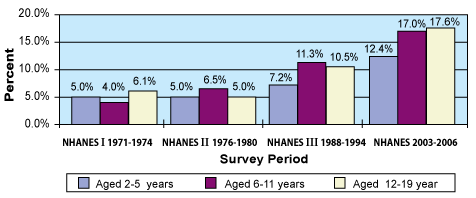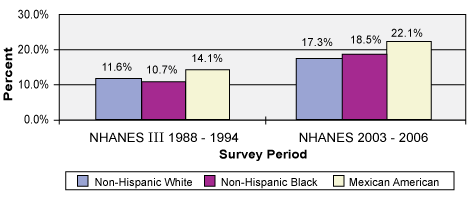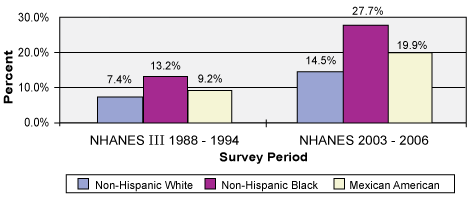Obesity Prevalence
Obesity is a serious health concern for children and adolescents. Data from NHANES surveys (1976–1980 and 2003–2006) show that the prevalence of obesity has increased: for children aged 2–5 years, prevalence increased from 5.0% to 12.4%; for those aged 6–11 years, prevalence increased from 6.5% to 17.0%; and for those aged 12–19 years, prevalence increased from 5.0% to 17.6%.1, 46
Healthy People 2010 identified overweight and obesity as 1 of 10 leading health indicators and called for a reduction in the proportion of children and adolescents who are overweight or obese9, but the United States has made little progress toward the target goal.
Progress toward reducing the national prevalence of overweight and obesity is monitored using data from the National Health and Nutrition Examination Survey (NHANES). The most recent NHANES data (2003–2006) showed that for children aged 6 –11 years and 12–19 years, the prevalence of overweight was 17.0% and 17.6% respectively.1 These prevalence figures are more than three times the target prevalence of 5% set in Healthy People 2010.
Trends in Childhood Obesity
The following graphs show trends in childhood overweight based on NHANES data for various age groups, beginning with NHANES I (1971–1974) and ending with NHANES 2003–2006 (the most recently available published data).
Data from NHANES I (1971–1974) to NHANES 2003–2006 show increases in overweight among all age groups:
- Among preschool-aged children, aged 2–5 years, the prevalence of overweight increased from 5.0% to 12.4%.8, 46
- Among school-aged children, aged 6–11 years, the prevalence of overweight increased from 4.0% to 17.0%.8, 46
- Among school-aged adolescents, aged 12–19 years, the prevalence of overweight increased from 6.1% to 17.6%.8, 46
|
Prevalence of Obesity* Among U.S. Children and
Adolescents (Aged 2–19 Years) | ||||
|---|---|---|---|---|
| Survey Periods | ||||
|
NHANES II 1976–1980 |
NHANES III 1988–1994 |
NHANES 1999–2002 |
NHANES 2003–2006 | |
|
Ages 2 through 5 |
5% | 7.2% | 10.3% | 12.4% |
|
Ages 6 through 11 |
6.5% | 11.3% | 15.8% | 17.0% |
|
Ages 12 through 19 |
5% | 10.5% | 16.1% | 17.6% |
|
*Sex-and age-specific BMI ≥ 95th
percentile based on the CDC growth charts Ogden CL, Flegal KM, Carroll MD, Johnson CL. Prevalence and trends in overweight among U.S. children and adolescents, 1999–2000. JAMA 2002;288:1728–1732. Hedley AA, Ogden CL, Johnson CL, Carroll MD, Curtin LR, Flegal KM. Prevalence of overweight and obesity among US children, adolescents, and adults, 1999–2002. JAMA 2004;291:2847–2850. Ogden CL, Carroll MD, Flegal KM. High Body Mass Index for Age Among US Children and Adolescents, 2003�06. JAMA 2008;299:2401�05. |
||||
|
Prevalence of Obesity* Among U.S. Children and
Adolescents (Aged 2 –19 Years) National Health and Nutrition Examination Surveys |
|---|
 |
| *Sex-and age-specific BMI > 95th percentile based on the CDC growth charts. |
Obesity Among Racial/Ethnic Groups
Although obesity has increased for all children and adolescents over time, NHANES data indicate disparities among racial/ethnic groups. The following graphs compare the prevalence for racial/ethnic groups of adolescent boys and girls aged 12 through 19 years.
Racial/Ethnic Comparison: Boys Aged 12–19 Years
The most recent NHANES data (2003�06) showed that for boys, aged 12–19
years:
- The prevalence rate of obesity was higher among adolescent Mexican-American boys (22.1%) and than among non-Hispanic white boys (17.3%) and black boys (18.5%).46
Data from NHANES III (1988�94) through NHANES 2003�06 showed that the largest increases in the prevalence of obesity occurred among adolescent non-Hispanic black boys (7.8%) and Mexican American boys (8.0%) compared to non-Hispanic white boys (5.7%).
- Among non-Hispanic white boys, the prevalence of obesity increased from 11.6% to 17.3%.
- Among non-Hispanic black boys, the prevalence of obesity increased from 10.7% to 18.5%.
- Among Mexican American boys, the prevalence of obesity increased from 14.1% to 22.1%.
|
Adolescent Boys Prevalence of Obesity* by Race/Ethnicity (Aged 12–19 Years) | ||
|---|---|---|
| Survey Periods | ||
|
NHANES III 1988–1994 |
NHANES 2003–2006 | |
| Non-Hispanic White | 11.6% | 17.3% |
| Non-Hispanic Black | 10.7% | 18.5%. |
| Mexican American | 14.1% | 22.1%. |
|
*Sex-and age-specific BMI ≥ 95th
percentile based on the CDC growth charts Ogden CL, Flegal KM, Carroll MD, Johnson CL. Prevalence and trends in overweight among U.S. children and adolescents, 1999–2000. JAMA 2002;288:1728–1732. Hedley AA, Ogden CL, Johnson CL, Carroll MD, Curtin LR, Flegal KM. Prevalence of overweight and obesity among US children, adolescents, and adults, 1999–2002. JAMA 2004;291:2847–2850. Ogden CL, Carroll MD, Flegal KM. High Body Mass Index for Age Among US Children and Adolescents, 2003�06. JAMA 2008;299:2401�05. |
||
|
Adolescent Boys Prevalence of Obesity* by Race/Ethnicity (Aged 12–19 Years) National Health and Nutrition Examination Surveys |
|---|
 |
| *Sex-and age-specific BMI > 95th percentile based on the CDC growth charts. |
Racial/Ethnic Comparison: Girls Aged 12–19 Years
The most recent NHANES data (2003�06) showed that for girls, aged 12–19 years:
- Non-Hispanic black girls had the highest prevalence of obesity (27.7%) compared to that of non-Hispanic white (14.5%) and Mexican American 19.9%) girls.46
Data from NHANES III (1988�94) through NHANES 2003–2006 showed that non-Hispanic black adolescent girls experienced the largest increase in the prevalence of obesity (14.5%) compared to non-Hispanic white adolescent (7.1%) and Mexican American adolescent (10.7%) girls.
- Among non-Hispanic white girls, the prevalence of obesity increased from 7.4% to 14.5%.
- Among non-Hispanic black girls, the prevalence of obesity increased from 13.2% to 27.7%.
- Among Mexican American girls, the prevalence of obesity increased from 9.2% to 19.9%.
|
Adolescent Girls Prevalence of Obesity* by Race/Ethnicity (Aged 12–19 Years) | ||
|---|---|---|
| Survey Periods | ||
|
NHANES III 1988–1994 |
NHANES 2003–2006 | |
| Non-Hispanic White | 7.4% | 14.5% |
| Non-Hispanic Black | 13.2% | 27.7% |
| Mexican American | 9.2% | 19.9% |
|
*Sex-and age-specific BMI ≥ 95th
percentile based on the CDC growth charts Ogden CL, Flegal KM, Carroll MD, Johnson CL. Prevalence and trends in overweight among U.S. children and adolescents, 1999–2000. JAMA 2002;288:1728–1732. Ogden CL, Carroll MD, Flegal KM. High Body Mass Index for Age Among US Children and Adolescents, 2003�06. JAMA 2008;299:2401�05. |
||
|
Adolescent Girls Prevalence of Obesity* by Race/Ethnicity (Aged 12–19 Years) National Health and Nutrition Examination Surveys |
|---|
 |
| *Sex-and age-specific BMI > 95th percentile based on the CDC growth charts. |
Tips for Parents
What can you do as a parent or guardian to help prevent childhood
overweight? We have some ideas in our Healthy Weight section.
![]() Please note: Some of these publications are available for download only as *.pdf files. These files require Adobe Acrobat Reader in order to be viewed. Please review the information on downloading and using Acrobat Reader software.
Please note: Some of these publications are available for download only as *.pdf files. These files require Adobe Acrobat Reader in order to be viewed. Please review the information on downloading and using Acrobat Reader software.
* Links to non-Federal organizations found at this site are provided solely as a service to our users. These links do not constitute an endorsement of these organizations or their programs by CDC or the Federal Government, and none should be inferred. CDC is not responsible for the content of the individual organization Web pages found at these links.
Page last updated: April 1, 2009
Content Source: Division of Nutrition, Physical Activity and Obesity, National Center for Chronic Disease Prevention and Health Promotion
